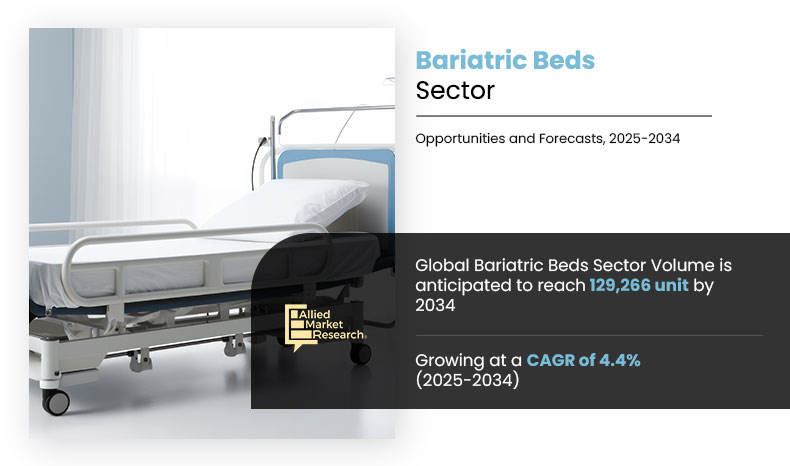Volume Insights on Bariatric Beds Sector
The global bariatric beds sector volume projection was valued at 84,350 units in 2024 and projected to reach 129,266 units by 2034, registering a CAGR of 4.4% from 2025 to 2034.

Volume Insights- A Strategic Overview?
Allied Market Research announces the release of its comprehensive analysis of the global bariatric beds industry. Bariatric beds are specialized medical devices designed to support patients with obesity or mobility limitations, playing a vital role in acute care, long-term care, and homecare settings. The growing global obesity burden, rise in geriatric population, and increase in prevalence of chronic conditions, such as diabetes and cardiovascular diseases, are some of the key factors driving the demand for bariatric beds. In addition, rise in incidence of post-surgical immobility and enhanced focus on patient safety & comfort contribute to the adoption of these beds across various healthcare settings.
The report highlights the expanding utilization of medical bariatric beds sector volume application in both hospital and homecare environments, particularly in post-operative care, geriatric care, and rehabilitation centers. The bariatric beds sector volume growth is driven by the increase in obesity-related hospitalizations, expanded reimbursement policies in developed regions, and surge in demand for durable and ergonomic patient support systems. Moreover, the trend toward adjustable, multi-function beds with powered positioning and enhanced safety features supports volume demand across healthcare systems seeking to minimize caregiver injuries and improve patient outcomes.
The moderate growth in the adoption of bariatric beds is attributed to their capability to handle high-weight capacities, reduce pressure ulcers, and facilitate easier patient handling. The global volume of bariatric beds is expected to grow from 84,350 units in 2024 to 129,266 units by 2034, registering a CAGR of 4.4% during the forecast period. The rapid expansion is supported by innovations such as tool-free adjustments, antimicrobial mattress designs, and seamless integration with monitoring equipment, especially with a shift toward decentralized care and expansion of long-term care facilities.
Regional Bariatric beds Sector Volume Growth?
Asia-Pacific dominated the bariatric beds sector sales with 34.43% share in 2024, and is expected to grow with a 5.5% CAGR, while North America, Europe, and LAMEA are expected to grow at 3.0%, 3.7%, and 4.8% CAGR during the forecast period, respectively, fueled by the increase in incidence of obesity, rise in investments in eldercare infrastructure, and government-driven improvements in public health facilities.
The regional analysis highlights significant variations in adoption trends and field potential across the globe. Asia-Pacific led the bariatric beds sector volume share, contributing over 34.43% of the total volume in 2024 and is expected to grow at a CAGR of 5.5 during the forecast period driven by rise in obesity prevalence, surge in demand for advanced patient care equipment, and increase in geriatric population requiring long-term care solutions. Furthermore, rise in number of establishments of specialized bariatric care centers and government-led efforts to upgrade healthcare infrastructure in countries such as China and India significantly boost demand for these beds, making the region a dominant player in the bariatric beds sector.
North America, led by the U.S. and Canada, is projected to maintain steady growth at a 3.0% CAGR. Europe, with key players such as the UK, Germany, France, and other countries, is expected to grow at a 3.7% CAGR, supported by the increasing elderly population, government emphasis on reducing hospital-acquired complications, and ongoing investments in rehabilitation & eldercare centers.
The strong presence of bariatric product manufacturers and availability of homecare assistance programs further stimulate consistent demand across the region. Meanwhile, LAMEA is expected to witness significant growth opportunities with a 4.8% CAGR, fueled by increasing bariatric surgical interventions and greater attention to obesity-related healthcare challenges in areas such as the Middle East and Africa. Moreover, strategic collaborations, international aid for hospital development, and the increase in the number of private healthcare facilities play a crucial role in driving demand for bariatric support systems across underdeveloped regions.
Bariatric Beds Sector Volume Growth, By Region, 2024-2034 (Units)
Region | 2024 | 2028 | 2034 | CAGR (2025–2034) |
North America | 21,508 | 24,289 | 28,965 | 3.0% |
Europe | 24,289 | 28,229 | 35,124 | 3.7% |
Asia-Pacific | 29,046 | 36,262 | 49,909 | 5.5% |
LAMEA | 9,507 | 11,542 | 15,268 | 4.8% |
Total | 84,350 | 100,322 | 129,266 | 4.4% |
Source: AMR Analysis
Bariatric beds Country Sector Sales
China and the U.S. lead the bariatric beds sector volume forecast, projected to reach 12,446 units and 18,787 units by 2034 at 6.2% and 3.2% CAGR, respectively, while India (6.0% CAGR) and Brazil (5.3% CAGR) are anticipated to be high-growth regions due to increase in prevalence of obesity, rise in number of bariatric surgeries, and healthcare modernization.
The report identifies China and the U.S. as the largest contributors to the bariatric beds sector in terms of volume. China, with its rapidly increasing obesity rates, aging population, and rising demand for advanced patient support equipment, is projected to reach 22,667 units by 2034, registering a CAGR of 6.2%. The U.S., on the other hand, remains an important player in North America, growing at a steady 3.2% CAGR and accounting for 25,769 units by 2034.
Major countries such as India and Brazil are expected to drive substantial growth in bariatric beds sector volume due to increase in awareness of obesity-related complications, surge in demand for specialized hospital beds, and rise in focus on long-term care services. India, with its rising bariatric surgery rates and expansion of healthcare infrastructure, is expected to witness a CAGR of 6.0%, benefiting from improvements in hospital capacity and patient mobility solutions. Brazil, representing Latin America, is projected to grow at a CAGR of 5.3%, supported by increase in number of public-private partnerships in healthcare, upgrades in hospital facilities, and efforts to expand bariatric treatment access across the country.
Bariatric beds Sector Volume Share, By Country, 2024-2034 (Units)
Country | 2024 | 2028 | 2034 | CAGR (2024-2035) |
U.S. | 18,787 | 21,373 | 25,769 | 3.2% |
Germany | 4,438 | 5,256 | 6,724 | 4.2% |
China | 12,446 | 15,913 | 22,667 | 6.2% |
India | 4,167 | 5,303 | 7,504 | 6.0% |
Brazil | 2,876 | 3,555 | 4,832 | 5.3% |
Source: AMR Analysis
Key Highlights by Stakeholders
Highlighting the significance of this report, Anshul Mishra, Associate Vice-President of Allied Market Research, stated, “Surge in demand for bariatric beds due to the rise in number of obesity-related hospitalizations and increase in focus on patient safety offers a significant opportunity for market expansion. Our latest report captures the market's dynamics, providing actionable insights for stakeholders aiming to capitalize on this opportunity.”
He further added, “Asia-Pacific, with its rapidly growing bariatric population and expanding network of specialized care facilities, remains the most promising region. At the same time, technological advancements in patient mobility systems and supportive healthcare policies in North America and Europe drive steady growth in these regions. With this comprehensive analysis, we aim to empower our clients with the knowledge needed to make informed business decisions.”
Bariatric beds Sector Volume Trends
The report also highlights the increasing importance of ergonomic design and patient-centric engineering in bariatric bed development to meet the rise in need of enhanced comfort and safety in clinical care environments. With evolving healthcare standards and heightened focus on mobility & pressure injury prevention, the shift toward innovative materials, such as antimicrobial-coated and biodegradable bariatric beds, is expected to accelerate in the coming years. These innovations are anticipated to boost demand for high-performance, specialized bariatric beds tailored to diverse acute and long-term care needs.
Furthermore, the study discusses the potential impact of global healthcare challenges, including the surge in obesity rates and the increase in demand for home-based and outpatient care. With an increase in emphasis on personalized patient management, fall prevention, and caregiver support, bariatric beds are expected to witness surge in their use across both hospital and residential care settings. The focus on cost-effective patient handling solutions, precision-based equipment design, and improved clinical outcomes further positions bariatric beds as a vital component in enhancing patient quality of life and caregiver efficiency.
Medical device and supplies manufacturers should use the report’s insights to grab new opportunities and plans.
About Allied Market Research
Allied Market Research is a full-service market research and business consulting firm, which provides actionable insights and strategic recommendations to help clients make informed decisions and achieve sustainable growth. For more inquiries, please visit alliedmarketresearch.com


